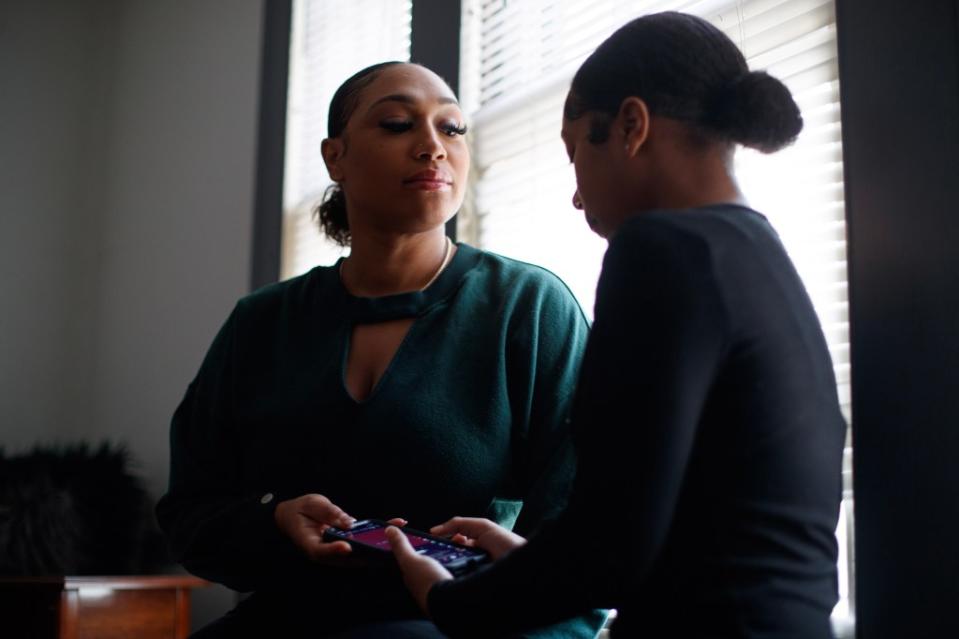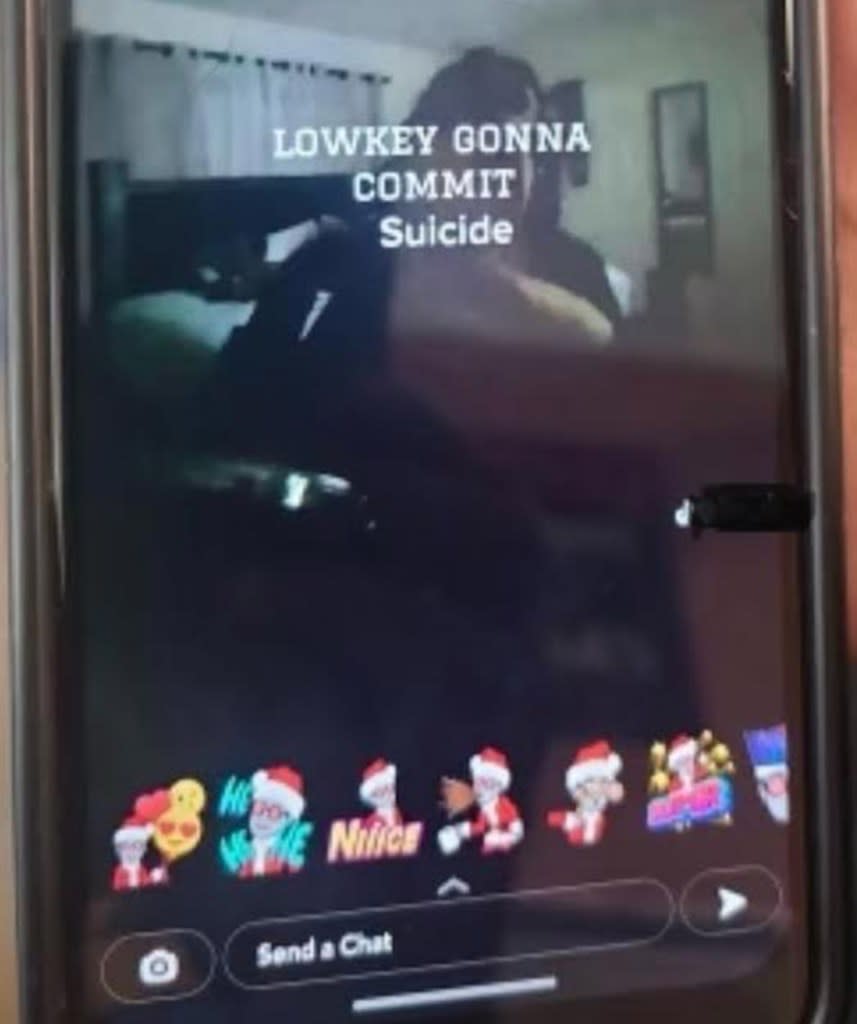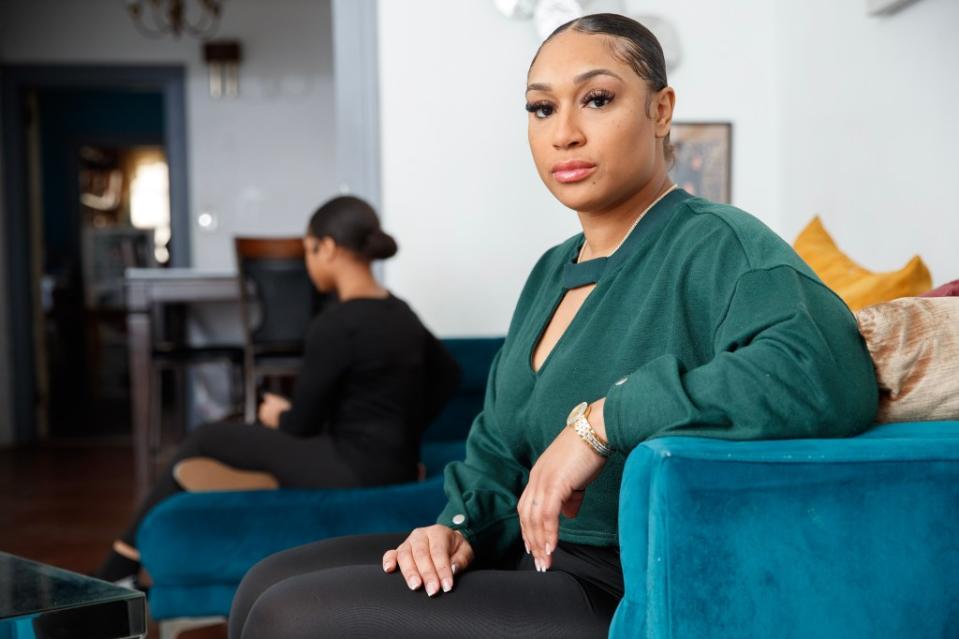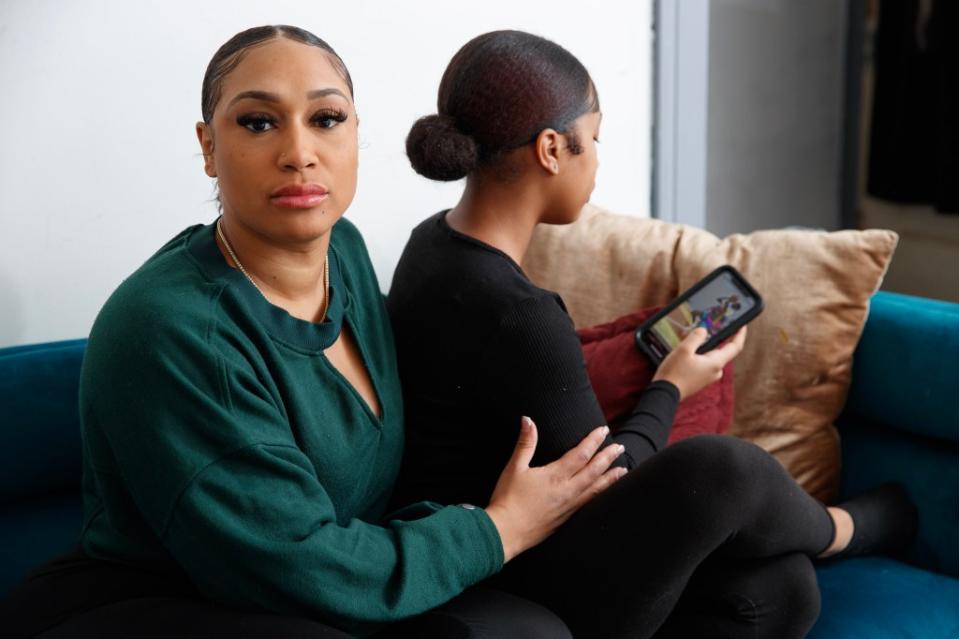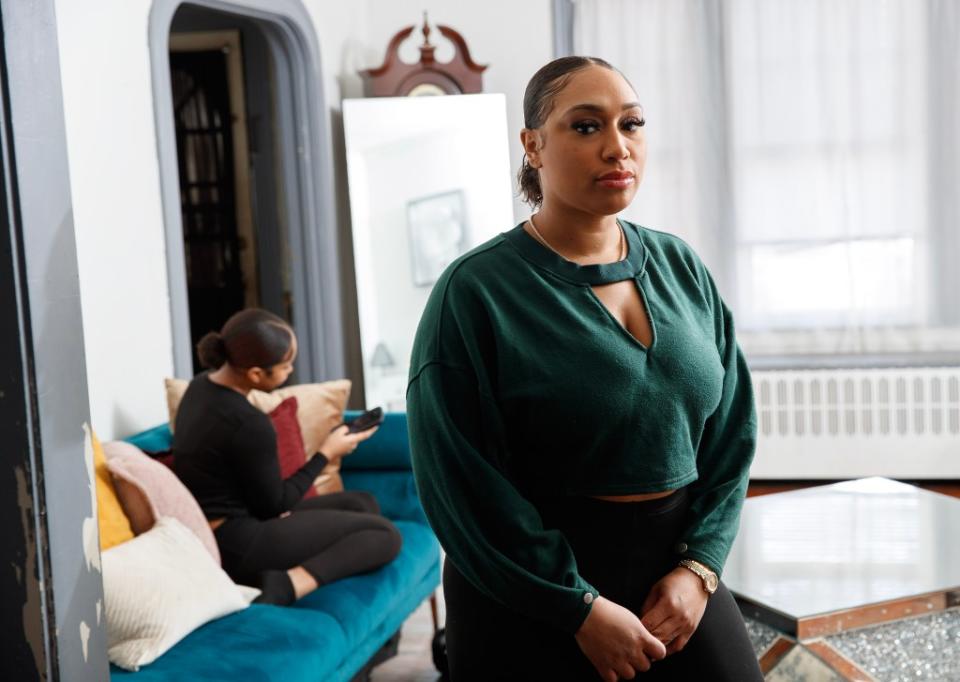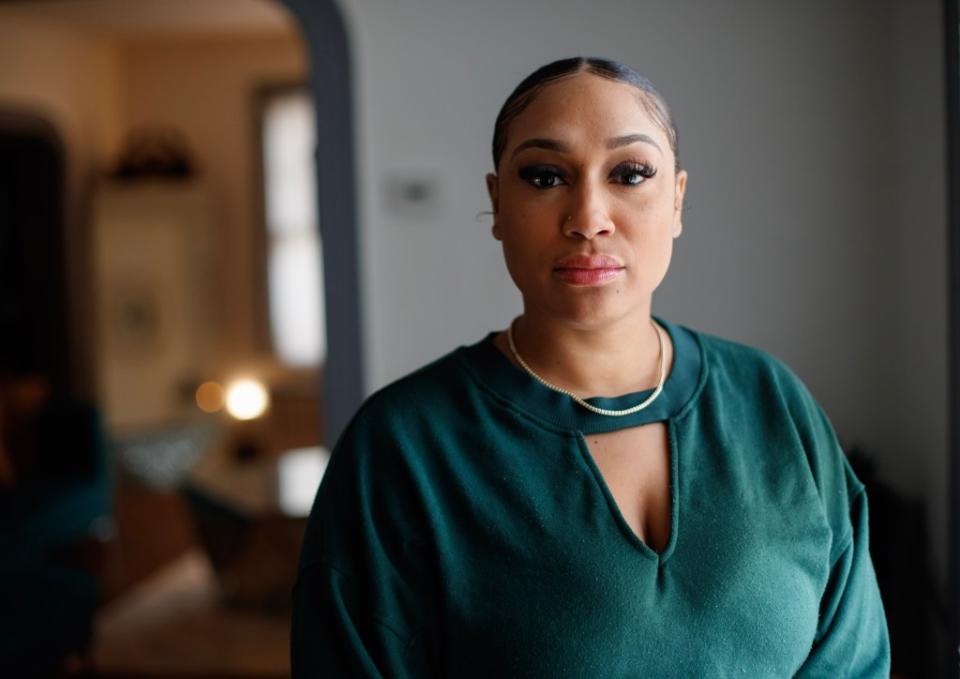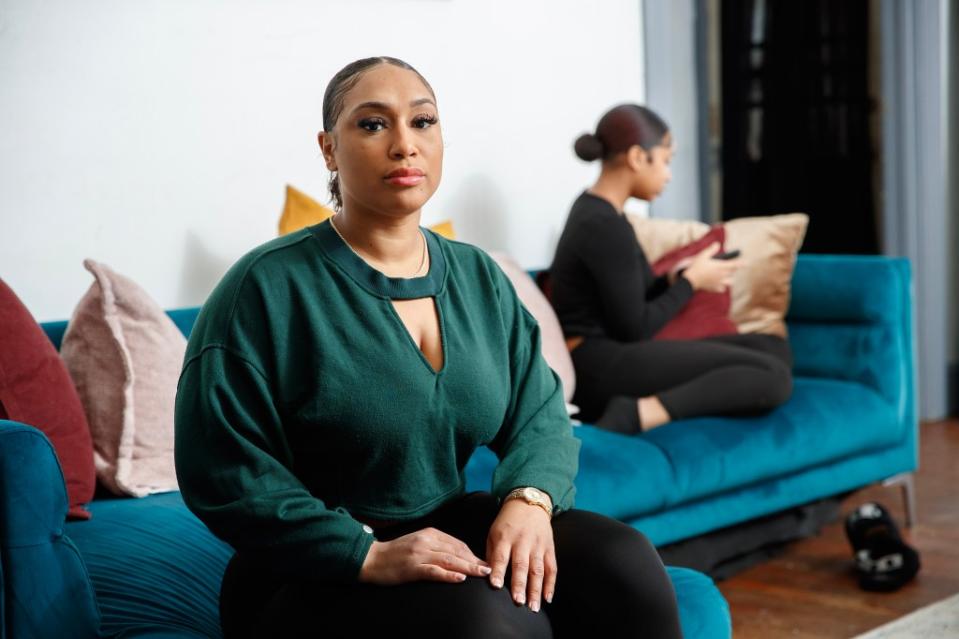TikTok ruined my kid’s life — now I’m suing it with 5,000 other parents
When Brittany Edwards discovered a distressing post on her 12-year-old daughter’s TikTok account indicating thoughts of self-harm, she was beside herself.
“At first, I was pissed off, I was angry, I was upset,” Edwards, 34, told The Post. “I didn’t understand where this was coming from or why she said that or why she posted that.”
The single mother of three was informed of her post when another mom texted to ask if everything was OK.
“I’m like, ‘What? What do you mean, what’s going on? Because I’m home. We’re all home,’ ” she shared.
That’s when Edwards was sent a screenshot of her daughter’s post that explicitly stated, “LOWKEY GONNA COMMIT Suicide.”
Naturally, the nurse from Hartford, Connecticut, felt overwhelmed and confused. She is now one of 5,000 parents using Claimshero.io to sue TikTok, which has been dubbed “the big tobacco of the digital age.”
“In July 2023, TikTok quietly introduced a provision in its user agreement that requires parents to file a claim within a year [of them creating an account] or lose their chance at pursuing damages forever,” ClaimsHero founder Kelvin Goode explained to The Post.
“Given this limited window, it’s more urgent now than ever for parents and guardians to hold TikTok accountable so families like Brittany’s can pursue justice for the injuries caused by the most addictive app on the planet.”
TikTok, which is owned by Chinese internet company ByteDance Ltd, also implemented a “no class action” clause that hinders unity, forcing families to handle the issue individually and leaving ClaimsHero to stand in the gap and mediate the battle against TikTok.
“We are deeply invested in the safety and well-being of our community, especially teens,” a TikTok spokesperson told The Post. “TikTok provides industry-leading safeguards, including age-restricted features with limits on direct messaging and livestreams, private accounts by default for younger teens, and parental controls.”
‘My shining star’
Edwards said it’s been an emotional roller coaster since her daughter was always an “outgoing happy-go-lucky girl” who “could light up a room.”
“She was my little shining star,” Edwards said.
At first, Edwards didn’t know her daughter had a TikTok and when she questioned her daughter, she said she signed up for it on her own with her email and made up a birth date.
However, TikTok notes in its “Guardian’s Guide” that the platform “is only for those aged at least 13 … and it’s important that your teen provides their real date of birth.”
Edwards’ conversation with her daughter about her troubling post started with some yelling.
“I didn’t know how to react,” she said. “I don’t know if I would take back the way I reacted because it was natural. I was scared, I was confused.
“I don’t know if it was maybe a trend she was trying to follow to fit in, or if she honestly really felt like that,” she added. “Just me thinking about if she was to actually go ahead and do this and act this out, then I don’t know how I would be able to take it past that.”
‘TikTok brain’
A technical investigation from Amnesty International found that young people who watch mental health-related content on their TikTok “For You” page were being recommended “rabbit holes” of potentially harmful content, including videos that romanticize, normalize or encourage suicide.
Reports from Amnesty International show that the platform’s content recommender system and invasive data collection practices amplify depressive and suicidal content that could risk making existing mental health conditions worse.
“The phenomenon of ‘TikTok brain’ results from watching personalized videos by using an algorithm designed to accurately predict which content is preferred to engage with,” Dr. Nina Cerfolio, a nationally recognized psychiatrist and trauma expert, explained to The Post. “There is an increase in dopamine within the brain’s reward center when using TikTok with the brain becoming addicted to ongoing dopamine secretion.”
Cerfolio said that this often “encourages teens to continue to use the site in order to feel ‘good’ having secured their entry into the herd.”
“This ‘good’ feeling paradoxically damages their belief in their own uniqueness and originality,” she added.
Edwards explained that her daughter was always a leader and a “cool kid,” but once she started using TikTok, she wanted to be more like the people she saw on the social media platform.
“I feel like she did it to fit in because even when I asked her, ‘Do you even know what suicide is? You know, you would never come back from that. That’s it. You don’t get a second chance,’ ” she said.
Michelle and Dean Nasca know that all too well after their 16-year-old son, Chase, died by suicide in 2022. Before his death, he had received more than 1,000 unsolicited videos of violence and suicide, which led to them filing a wrongful death lawsuit in New York state court.
TikTok declined to comment at the time due to pending litigation, but spokeswoman Jamie Favazza said the company is committed to safety for teens.
“Our hearts break for any family that experiences a tragic loss,” she said in a statement. “We strive to provide a positive and enriching experience and will continue our significant investment in safeguarding our platform.”
Addiction?
At first, her daughter used social media innocently — making dances and participating in viral trends.
But Edwards noticed that the more her daughter spent time on TikTok, the more she was “withdrawn from everyone.”
“As she continued using it daily, she would watch videos that had cursing in it or inappropriate dancing and just everything that wasn’t suitable for her age, in my opinion, in terms of sexual content, drug use — everything that I feel like wasn’t for her,” Edwards said.
“At that time, I would hear it and say, ‘no, change that,’ ‘put on something else,’ or ‘what are you watching?’ And she would flip through it, but every time that I would catch her, it was always the same thing.”
The average American will unlock their smartphone at least 150 times a day, Cerfolio said — and it got to the point where Edwards’ daughter was simply addicted to TikTok.
“She lives on TikTok. I mean, she’ll get up in the morning, she’s on TikTok until she gets out of her bed. While she’s brushing her teeth, app is on. If she’s having breakfast or whatever she’s eating while she’s at the table, or when she goes to lock herself in her room and she’ll have a snack, or she’s eating her dinner, she’s on TikTok.”
Edwards felt like she was constantly telling her daughter to delete the app off of her phone, but every time she would go back, there would just be a new account made with a different email and different username. She had about four different accounts within a year.
“Many of us have become so dependent and addicted to our phones that we have forgotten how to function without them,” Cerfolio said. “The world is no longer your oyster, it is your screen.”
Cerfolio explained that screen addiction is even more hindering for “teens whose brains are still developing” and they’re “even more susceptible to the addictive behavior encouraged by TikTok practices.”
‘I don’t know how long it will take for us to get over it’
Thankfully, Edwards shared that her daughter is doing better and going to therapy.
“I know as a parent I’m not going to be able to control her 24/7 — even when she’s at school,” Edwards said. “I know I can’t stop her 100% from using the app, but I just try to have open communication with her and try to monitor the best way that I can when I can.”
But even though Edwards’ daughter is doing better mentally, the incident has still affected the family.
“Honestly, I don’t know how long it will take for us to get over it — if we ever do or if we ever will,” she admitted.
The mom decided to go to ClaimsHero because she felt someone needed to be held accountable, but as a single mom, she knew there was no way she’d be able to afford a lawyer on her own.
“My child literally did a 360 and all it took was for her to be glued to a phone, somebody had to be held accountable for this,” Edwards said. “[ClaimHero’s] views were similar to mine in terms of how they felt about TikTok with the way it’s becoming addictive to kids.”
Teen mental health decline
Recent reports from the Centers for Disease Control and Prevention have revealed a bleak picture of teen girls’ mental health.
The CDC’s biannual Youth Risk Behavior Survey showed that 57% of teen girls felt persistently sad or hopeless in 2021, which is double the rate for teen boys (29%). Nearly one in three teen girls seriously considered attempting suicide.
The survey showed that nearly all indicators of poor mental health among high schoolers, including suicidal thoughts and behaviors, have increased in the last decade.
Edwards hopes that the lawsuit will nudge TikTok to put some sort of parental filters on the app, such as filtering the algorithm for age-appropriate content or somehow make it less addictive, and bring light to the issue that so many families are facing.
“It literally turned my kid into a person that can’t live without her phone,” she shared. “She’ll lose her mind.”
“I hope to see that maybe they can fix it somehow, so that way our kids are not glued to their phone all the time. That’s honestly what I would like to see happen.”
TikTok’s Guardian’s Guide points to “Family Pairing features” which advises “parents link their TikTok account to their teen’s to enable a variety of content, privacy, and well-being settings.”
However, Edwards advised parents whose kids don’t already have TikTok to not allow them to download it if possible, but if they do already have the app, to build a better rapport than what already exists between parent and child.
“TikTok is making it so easy for you to just keep creating these accounts that you won’t even know that your kid has it,” she said. “And if they see that they’re experiencing these same mental health issues like my daughter did, then I would refer them to ClaimsHero, and hopefully they can help them out as well, just like they’re helping me.”
‘Safety first’
However, Cerfolio cautioned not to “throw out the baby with the bathwater,” saying that there are some TikTok trends that can be beneficial to our mental health — such as silent walking, which “allows you to unplug from the strain of daily life and tune in to being more present.”
“There is much useful information on meditation and wellness on TikTok,” she explained. “That being said, you must be alert that a lot of information is not checked for accuracy and may provide false information.”
Dr. Katie Hurley, senior clinical adviser at The Jed Foundation (JED), echoed Cerfolio’s stance, saying: “Teen mental health is complex and use of social media platforms, including TikTok, can have both positive and negative impacts on teen users.
“We do not yet have enough evidence to fully understand the impacts of social media on teen mental health, which is why it is so important that we apply a ‘safety first’ approach to online platforms just as we do to medications, toys and cars.”
If you or someone you know is affected by any of the issues raised in this story, call the 988 Suicide Crisis Lifeline at 988 or visit 988Lifeline.org.
